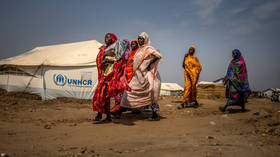Brazil has already lost and it’s the people who pay the price

“We don’t need the World Cup. We need health and education,” hand-written placards say during the recent demonstrations against the FIFA World Cup in Brazil.
Envisaged to give Brazil's economy a second wind, the spiraling costs of building modern-day temples has caused a veritable storm. While the protests have diminished in recent weeks and the beautiful game has taken over, the questions facing Brazilian society remain the same: Where and how is money spent in Brazilian society?
In Brazilian cities such as Porto Alegre citizens were allowed to democratically decide how their tax money was spent, and how their public services run through 'participatory budgeting' at the beginning of this century. Today, Lula’s successor Dilma Rousseff and her left-wing Workers' Party (PT) have turned from people's power to the power of hosting mega-events for the one per cent. And the FIFA and the IOC dictate their budgets – even beyond the gates of the Maracana Stadium. The human cost involved should not come as a surprise.
'They robbed the people’
Even before the slowing-down of the world economy in 2008, mega-events such as the Olympic Games or the FIFA World Cup were disastrous for large sections of the local population. In their article “Impacts of the Olympic Games as mega-events”, Malfas, Theodaraki and Houlihan outline how more than 15,000 residents were evicted from public housing projects for the Olympic Centenary in Atlanta, Georgia in 1996. Meanwhile, homeless shelters were converted into backpacker hostels during the Games themselves.

In the run-up to this World Cup, displacement and gentrification have reached new heights. Street children have been removed from the city centers and the vicinity of the stadiums for the duration of the games just to find themselves homeless once the winner of the World Cup is announced. The losers of this World Cup have not been Portugal, England, Italy or Spain who entered this tournament with high aims yet were eliminated at the group stage. The real losers are the inhabitants of Brazil’s popular neighborhoods – the favelas. More than 250,000 people have already been (or at are at risk of being) removed, with 90,000 in Sao Paulo alone. The situation will only worsen with the Rio Olympics only two years away.
Former football star, Romario, has harshly criticized FIFA and
the World Cup. He told the New York Times: “FIFA got
what it came for: money. If you spend 30 percent less on
stadiums, they’d be able to improve other things that actually
matter…They found a way to get rich on the World Cup and they
robbed the people instead. This is the real shame.”
Survey after survey has shown that the majority of Brazilians
have been against holding the World Cup in their
country.
Yet, they have been denied any say at a political level. Nor do
they have any stake in how the revenue generated from this
mega-event could be used in the future.
Where do all the profits go?
Of course, the World Cup has created jobs in areas stricken with high rates of poverty and illiteracy, but the vast majority of these jobs are low-paid and temporary. Jobs in construction, the service-industry, and sex and tourism sector are not a viable economic plan to secure Brazil’s future as an engine of growth. Thus, FIFA’s promise of development is nothing less than a sick joke.
In fact, construction workers have had to pay with their lives. Reports claim that at least eight workers were killed while the numbers of those injured in work-related accidents is far higher. Meanwhile architectural companies with locust-like behavior such as the German architectural firm GMP make record profits from their lucrative deals with FIFA. By now it should be more than obvious that GMP who also designed and planned the stadium for the 2010 World Cup in Durban, South Africa will not reinvest its profits into Brazil but will move on to wherever the buck stops next.

The money generated from television rights, merchandise, and drink sales during the World Cup will not trickle down into the local economy or be re-invested where it was made. Instead it flows back to Switzerland where FIFA – nominally a charity - currently sits on more than one billion tax-exempt US Dollars. To make matters worse, Budweiser, one of the World Cup’s prime sponsors, forced the Brazilian government to renege on its alcohol ban in football stadiums thus undermining its democracy and sovereignty.
Yet for Brazil’s tiny elite this is a perfect storm and a once-in-a-lifetime opportunity to restructure society in its own image. By hosting mega-events such the Pan-Am Games (2007), the Confederations Cup (2013), the World Cup and then the Olympic Games in 2016 they hope to turn their state into one big gated-community and show that Brazil is a global player able to compete against the EU and USA. While hosting World Cups does not deliver growth, as several studies have shown, it builds Brazil’s brand as a tourist destination. But this cheap marketing gimmick comes with a huge price tag attached to it.
Football for the One Percent
The story of modern football’s most glorious temple, the Maracana stadium, built for the 1954 World Cup epitomizes the changes happening throughout Brazilian society. In order for Maracana to meet “FIFA standards” the standing area had to be torn down and replaced with VIP-lounges. The original’s stadium capacity of approximately 200,000 has been reduced to roughly 75,000 in the course of the last decades.
Where once the crowds and "populares" roared to the goals of Pele, Socratés and Romario, the rich now wine and dine before or after visiting the stadium’s very own shopping mall. Brazilian photojournalist Sergio Moraes recently lamented that it is “soulless” and has nothing to do with the stadium that once was labeled the “Sistine Chapel of Football”.
Much like stadiums and arenas of the 2004 Athens Olympics resemble ruins in Ancient Olympia today, it is likely that the Arena de Amazonias in Manaus will suffer the same fate. After only four games in the group stage, the lights have already been turned off. There is simply no demand for a stadium with 41 000 seats in a city cut off from major motorways and with neither a first or second league team. But it appears that Rousseff and Brazil’s elite could not care less as long as Brazil’s team, the Selecao, performs well.
For as long as they remain in the competition Brazil’s fundamental problems can be brushed under the carpet with relative ease. But the final is only two weeks away and one thing is already certain: Brazil’s majority has lost off the pitch.
The statements, views and opinions expressed in this column are solely those of the author and do not necessarily represent those of RT.
The statements, views and opinions expressed in this column are solely those of the author and do not necessarily represent those of RT.















